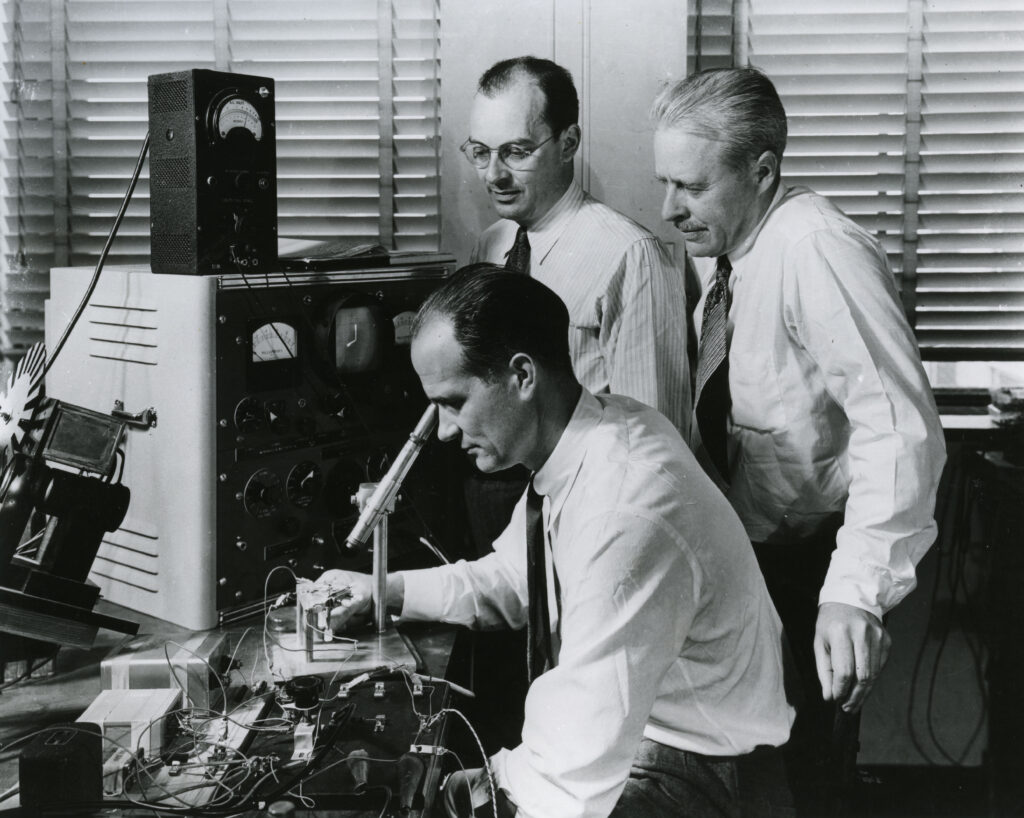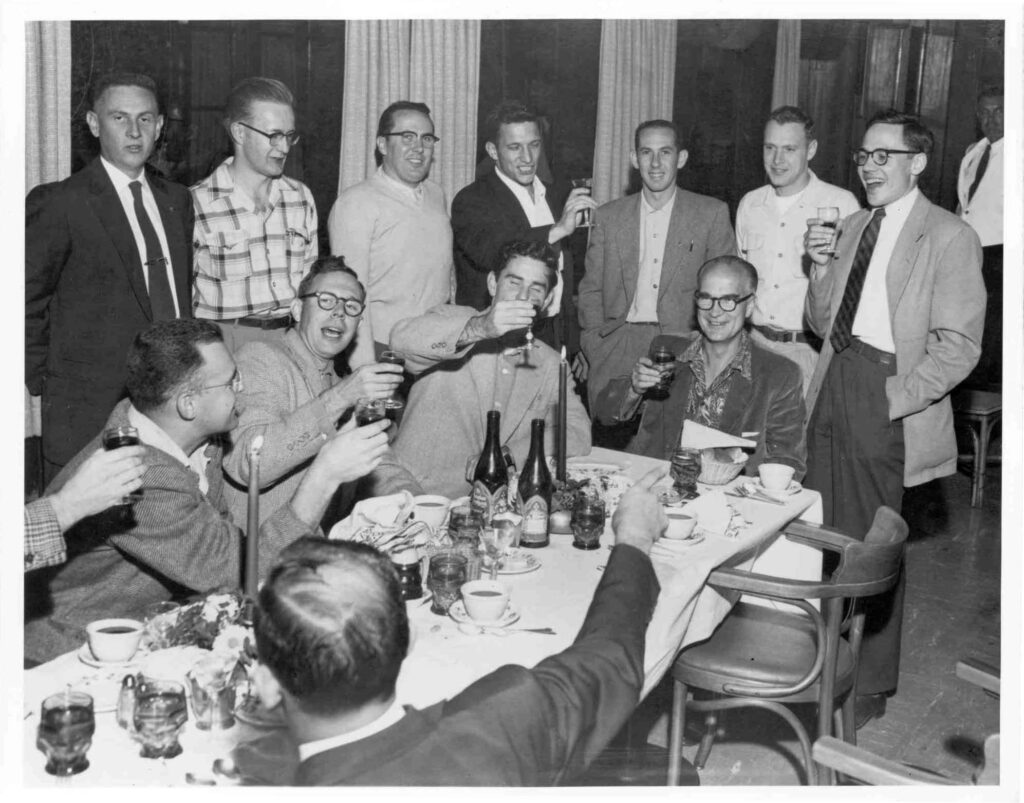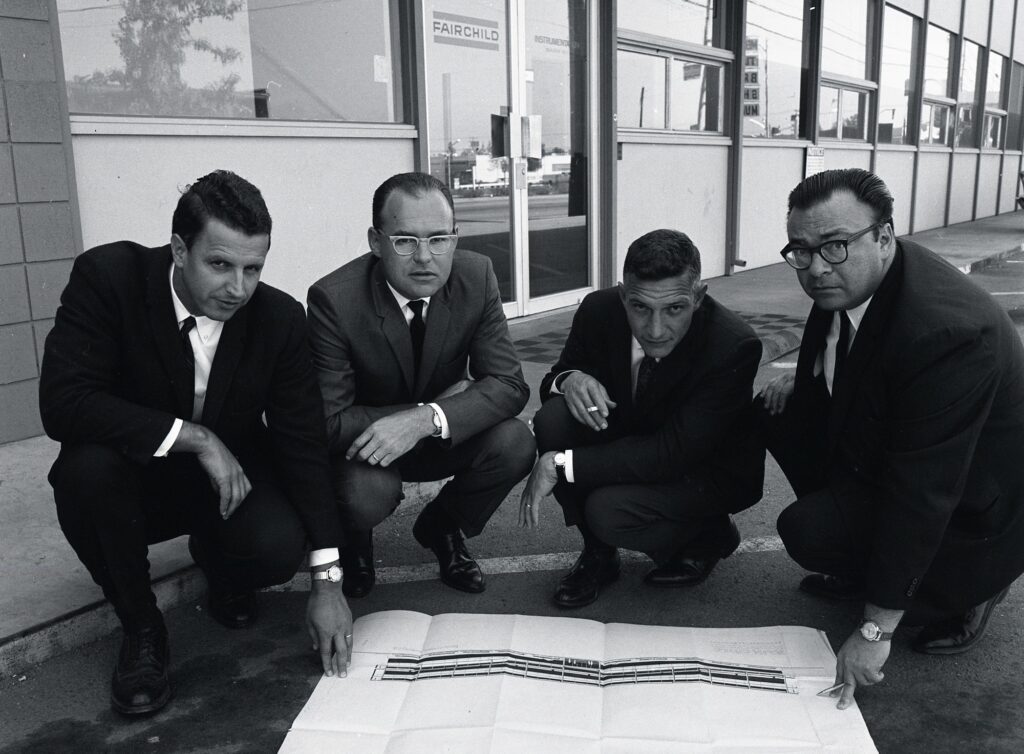
Gordon Earle Moore died on March 24, 2023, at the age of 94. Moore was a man of parts, with wide-ranging talents and accomplishments. His most longstanding commitments were those to his family—as husband of 73 years to Betty I. Moore and as father to sons Ken and Steve Moore—to the study of science and technology, and to sport fishing. Moore was also a PhD chemist, semiconductor manufacturing technologist, self-described “accidental entrepreneur,” industrial R&D leader, corporate executive, venture investor, and philanthropist.
Moore is perhaps most widely known for the phenomenon of “Moore’s Law,” the developmental dynamic in silicon microchips that, for over a half-century, resulted in exponential increases in the complexity and functionality of microchips with accompanying exponential decreases in the cost of digital electronics. This dramatic increase in the functionality and affordability of digital electronics in the form of the silicon microchip has been foundational to the widespread use of digital electronics and computation globally, and in all areas of society and culture, thereby producing our contemporary digital world. Through roles in technology and business leadership at the two most important silicon microchip firms to date—Fairchild Semiconductor and the Intel Corporation—both of which he cofounded, Gordon Moore served as a key architect of our digital world.
A 16-minute biographical film about Gordon Moore, cowritten by Computer History Museum historian David C. Brock.
Born on January 3rd, 1929, in San Francisco, Moore spent his first decade in the coastal farming village of Pescadero, north of Santa Cruz on the San Francisco Peninsula. Moore’s family had been the first Anglo settlers of the village in the 1840s, and for the most of his life he lived and worked within a forty-mile radius of his childhood home. Moore’s father was a deputy sheriff, and his mother was a Pescadero native. In was in Pescadero, appropriately, that Gordon Moore developed his lifelong passion for sport fishing.
The family moved to Redwood City at the close of the 1930s, where Gordon Moore attended the public high school. It was in Redwood City that Moore was first exposed to a chemistry set and, with it, the capacity to make explosives. Moore soon turned a backyard shed into a sophisticated if risky explosives laboratory, undertaking various experiments with rocketry and detonation. Like many chemists before him, it was “flashes, bangs, and stinks” that drew Moore into the study of chemistry.
One of the first in his family to pursue higher education, Moore enrolled at San Jose State as his first step toward becoming a chemist. In his two years there, before transferring to the University of California, Berkeley, Moore met Betty I. Whitaker, a friendly, savvy, journalism major. They would soon marry in 1950, immediately after Gordon’s graduation with a BS in chemistry and days before he was to arrive to begin his graduate studies in chemistry at the California Institute of Technology, Caltech. Betty Moore was herself a native of the San Francisco Peninsula and devotee of sport fishing.
An oral history interview with Gordon Moore in 2008. The transcript is available here.
Moore quickly earned his PhD in physical chemistry at Caltech, where he specialized in experimental research in the field of infrared spectroscopy. His work required precise measurement, careful mathematical analysis, and intricate equipment for careful control of difficult materials. Moore then spent just over two years as a research chemist, refining these same skills, at the Applied Physics Laboratory, the guided missile laboratory of the US Navy operated by Johns Hopkins University. While there, he attended a public lecture by William Shockley, one of the nation’s preeminent physicists, and the recent inventor of the junction transistor at the Bell Telephone Laboratories. Interested in more directly applied work, Moore explored to a variety of positions, including a post at the Lawrence Livermore National Laboratory—then at the peak of its prominence—which Moore turned down. It was at Livermore, that William Shockley found Moore’s resume, prompting an out-of-the-blue telephone call from Shockley to Moore with the offer of a job back on the San Francisco Peninsula.

William Shockley (seated) with his Bell Labs colleagues John Bardeen (standing left) and Walter Brattain (standing right) in 1948. The trio later shared the Nobel Prize in physics for their pioneering work on the transistor. Credit: Bell Laboratories.
In 1955 and 1956, Shockley was busy assembling key staff for a new laboratory in Mountain View, California. Shockley had left Bell Labs, and joined forces with another Caltech PhD chemist, Arnold Beckman, who had built a large electronics and instrumentation firm, Beckman Instruments. Beckman, who already had two subsidiaries in the Bay Area, contracted with Shockley to create a new laboratory, the Shockley Semiconductor Laboratory of Beckman Instruments, Inc., in the Bay Area to develop and then mass produce a promising new form of junction transistor, the double-diffused silicon transistor. The new transistor was thought to have significant market potential for military applications and industrial automation. The manufacturing of these transistors was fundamentally a chemical process, and therefore Shockley needed experienced, sharp, experimental chemists in addition to electrical engineers, physicists, metallurgists, and mechanical engineers. Moore jumped at the chance to serve as one of these chemists, to apply his chemical knowledge and experimental skills to the forefront of electronics technology, and to return to the Bay Area.

The staff of Shockley Semiconductor salute William Shockley at a champagne brunch in honor of his Nobel Prize. Read the transcript of the 2006 oral history interview with several of the staff of Shockley’s laboratory.
The Shockley Semiconductor Laboratory quite literally brought silicon electronics to what became known as Silicon Valley, but its impact was broader. By 1957, Moore and seven other members of Shockley’s staff had become profoundly dissatisfied with the technological and strategic direction of the laboratory, and with its management by William Shockley and Arnold Beckman. Having voiced their concerns about lack of focus and commitment to producing the double-diffused silicon transistor to both, and having their proposals rebuffed, the eight dissidents decided to leave.

Cofounders of Fairchild Semiconductor at their first location at 844 Charleston Road in Palo Alto. From left to right, Vic Grinich, Gordon Moore, Robert Noyce, Julie Blank.
Realizing that the dissident group possessed all of the fundamental skills and knowledge to produce the double-diffused silicon transistor, and working with the New York investment bank Hayden Stone, the group eventually forged an agreement with defense contractor Fairchild Camera and Instrument to create a new firm, Fairchild Semiconductor Corporation, to manufacture the new silicon transistor. This was the first Silicon Valley spinoff, which would set the mold for hundreds of semiconductor and, later, IT startups and spinoffs.
At Fairchild Semiconductor, Moore made direct contributions to the technology for making the double-diffused silicon transistor and increasingly took on greater responsibility for the overall technology strategy for the firm. Fairchild Semiconductor’s technological and business success came rapidly. In just five years, with Moore directing R&D, the firm created a profitable business in silicon transistors and diodes, made cofounder Jean Hoerni’s conception of a new “planar process” for making devices into a technology adopted by the global semiconductor industry for making silicon electronics, and used the planar process to create the astonishingly successful silicon planar integrated circuit—the silicon microchip as we have come to know it. Further, the Fairchild Semiconductor founders all achieved financial independence when the parent company exercised its right to buy the firm, making it a division of Fairchild Camera and Instrument.

Gordon Moore’s original patent and laboratory notebooks from his career at Fairchild Semiconductor are preserved in the Computer History Museum’s collections, along with hundreds of other Fairchild notebooks and documents. See the Moore Patent Notebooks here: Notebook LN #2, Notebook # 6, Notebook LN #3, Notebook LN #4.
Among the original cofounders, Robert Noyce and Gordon Moore had become first among former equals. Noyce was the general manager for the semiconductor division, while Moore ran R&D. With the huge opportunity in electronics represented by the silicon microchip, the other six cofounders rapidly left for new silicon microchip startups. Moore was uniquely positioned to grasp and analyze this opportunity, as he had intimate knowledge of the silicon manufacturing technology and of the process of developing silicon microchips for digital electronics.
In 1963, Moore began to publish his analysis of the silicon microchip opportunity. Moore believed that the basic approach for manufacturing silicon microchips, a kind of chemical printing process, was open to dramatic refinement and extension. In short, with enough investment of creative effort, time, and money, the chemical printing process could be made almost arbitrarily better. There was no fundamental brick wall preventing future progress, at least not for decades. With this, Moore saw that the extensibility of the chemical printing process would favor, both in terms of cost and performance, making silicon microchips with ever more digital functionality. Ever tinier transistors would be formed together in ever greater numbers on silicon microchips that would perform more and more digital electronics. Silicon microchips would make digital electronics profoundly cheaper over time. As a result, they would eventually pervade all of electronics, and dramatically increase the use of digital electronics in society.
In a 1965 article on this analysis, appearing in the trade magazine Electronics under the title “Cramming More Electronics Onto Integrated Circuits,” Moore underscored his view with a prediction. The number of transistors put onto microchips was going to double every year, for at least the coming decade, in order to get the maximum economic benefit from digital electronics, that is, to make them cheaply and profitably. This regular doubling of microchip “complexity” for maximum economic benefit would have its timescale refined by Moore in coming years, as it would be come to be generally known as “Moore’s Law.” This regular doubling associated with exponential decreases in the cost of digital electronics did in fact play out over the next half century, providing the foundation for the creation of our digital world.
This 14-minute film, made for the 50th anniversary of Moore’s Law, provides in-depth background and explanation. It was cowritten by Computer History Museum historian David C. Brock. See Moore's original manuscript of what would become his famous 1965 publication in Electronics.
In 1968, Gordon Moore decided to leave Fairchild to create a new silicon microchip startup with Robert Noyce. Noyce was dissatisfied with the top management of the company, and Moore was increasingly frustrated that he could not successfully transfer new technologies out of his R&D laboratory into manufacturing. It was Moore who believed that the silicon microchip technology had advanced to the position where microchips could become a contender for use as computer memory. Digital silicon microchips were finding increasing use for computer logic—the parts of computers that perform calculations. The parts of computers that held the information to be calculated upon—computer memory—were formed from a cheap, reliable form of magnetic technology called core memory. Moore believed that by pushing the chemical printing process still further, silicon microchips could win computer memory from magnetic cores. Since computer memory was the bulk of the cost of digital computers, and the production of digital computers was continually expanding, Moore thought that memory microchips could be a tremendous business. In the summer 1968, Moore and Noyce created the Intel Corporation. Their first hire was Moore’s primary colleague in Fairchild R&D, Andy Grove.
While Moore and Noyce both made personal investments to create Intel, the bulk of the funding came from venture capital investments organized by Arthur Rock. Rock had been the principal financier behind the creation of Fairchild Semiconductor, who subsequently relocated to San Francisco to pioneer the business of venture capital partnerships for investing in high technology startups. Moore, like the other cofounders of Fairchild Semiconductor, were key early limited partners for Rock’s, and other's, venture capital partnerships. Indeed, all of the Fairchild Semiconductor cofounders were initial investors in Intel. Moreover, several Fairchild Semiconductor alumni established many of the most prominent venture capital firms in Silicon Valley, including Kleiner Perkins and Sequoia.
In this 2015 interview, Gordon Moore and Arthur Rock discuss the formation of Intel. The transcript is available here.
At Intel, Moore, Noyce, and Grove formed a triumvirate that led the firm for the next 30-plus years. Noyce was, until his untimely death in 1990, very much the public face and champion for the firm, working closely on strategic decisions with Moore and Grove. Moore served as the ultimate technological strategist for the firm, holding key decisions on investments in R&D and manufacturing capacity, as well as which types of products the firm would pursue. It was left to Grove the fantastically difficult remit of creating an organization to execute on these strategies and decisions, as well as driving it to do so.
As Executive Vice President of Intel to 1975, Moore made several technological contributions that helped the firm secure early leads and successes in the microchip memory business he had envisioned. Under Moore’s leadership, Intel came to lead the market for DRAM memory chips in this period and to pioneer the creation of and market for EPROM memory chips, the predecessor to today’s Flash memory. Further, Moore supported Intel’s creation of the first commercially successful microprocessor—the entire central processing unit of a computer on a single chip. Together, the microchip, DRAM, and the EPROM would become critical for the rise of personal computing. Read a 2007 oral history interview with the members of the Intel team behind the firm’s first microprocessor, the 4004.
From 1975 to 1987, Gordon Moore worked as Intel's longest serving CEO to date. In those years, Intel faced growing domestic and international competition in all of its markets for silicon microchips. Moore, with key advice and support from Grove, made several critical decisions in this period that set the stage for the dramatic success for the firm. Moore agreed to a strategic retreat from the DRAM business it had pioneered, reorienting the firm toward the microprocessor and, to a lesser extent, on non-volatile memory chips like the EPROM and Flash. In the microprocessor business, Moore approved a number of key strategies. Intel insured that its microprocessors were backward-compatible, allowing users to maintain their investment in software, most especially Microsoft’s operating systems and the application software written for them. Intel also engaged in aggressive marketing programs against their main rivals and targeted the end consumer with their “Intel Inside” campaign. Critically, Moore also approved the decision for Intel to act as the “sole source” for the Intel 386 microprocessor, a bet-the-company-scale move that resulted in Intel’s dominant franchise in commercial microprocessors outside of mobile devices.
Historian Richard Tedlow discusses the decision to sole-source the Intel 386 microprocessor.
Andy Grove became CEO in 1987 to 1997 in order to lead Intel's microprocessor strategy, with Moore acting as chairman of the board from 1987 to 1997. During these years, Moore took on greater responsibilities outside of the firm. In particular, he led an important effort that resulted in the Semiconductor Industry Association’s Technology Roadmap for Semiconductors. This roadmap, later expanded to include international partners, served as a mechanism by which the international semiconductor industry and its suppliers of materials and equipment worked together to explicitly maintain Moore’s Law.
After his chairmanship of Intel, Moore increasingly turned his attention to philanthropy. During the internet boom, Moore’s decades-long position on Intel had made him one of the wealthiest Americans. Most notably, Gordon and Betty Moore created the Gordon and Betty Moore Foundation in 2000 with a gift of several billion dollars. The foundation supports scientific research, environmental and conservation activities, and Bay Area concerns. Through this foundation and their private wealth, the Moore’s have made among the largest ever philanthropic gifts to higher education (Caltech) and environmental conservation (Conservation International). For the past several years, Gordon and Betty Moore have been living on the island of Hawaii, returning to the Bay Area regularly for meetings of their foundation’s board.
For a detailed history of semiconductor electronics, see the Museum’s online exhibition Silicon Engine.
Museum historian David C. Brock is the coauthor of a biography of Gordon Moore, Moore’s Law: The Life of Gordon Moore, Silicon Valley’s Quiet Revolutionary (Basic Books, 2015). A discussion about the book can be viewed here.